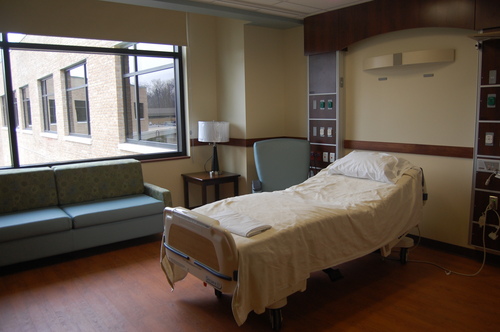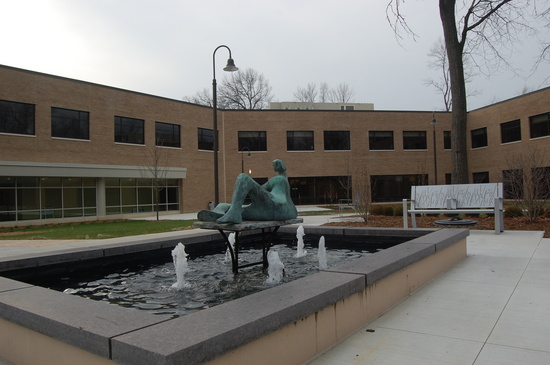Chelsea Community Hospital hopes to attract more patients with $40 million worth of improvements

A glass serpentine wall helps to guide visitors to the information desk at the expanded Chelsea Community Hospital.
Janet Miller | AnnArbor.com
The 38-year-old community hospital south of downtown Chelsea will more than double in size when its new facility comes online this month. The new building is 130,000 square feet and is connected to the 127,000-square foot existing hospital by two corridors.
Since patients have come to expect private rooms and other amenities, the expansion will help CCH compete in the health care marketplace, said Nancy Graebner, president and CEO of the hospital. In anticipation of the new facility opening, CCH began offering its patients room service, allowing them to order off a menu for breakfast, lunch and dinner. That has allowed the patients, rather than the hospital, to decide when meal times are.

One of the new private rooms at Chelsea Community Hospital.
Janet Miller | AnnArbor.com
The renovation is expected to result in at least modest growth over the next five years for CCH, Graebner said. “This places us in a new competitive environment.”
CCH will hold an open house for the new facility Sunday, Dec. 9, from noon to 5 p.m.
While the project includes a 54-bed addition, the hospital’s total number of licensed beds will remain at 113. Almost all of the rooms in the existing hospital will be converted from doubles to singles as part of an $8-million renovation project scheduled to start in 2013.
The new facility, which will come online Dec. 17, includes a 20-room emergency room, nearly doubling the capacity of the existing ER. During peak times, patients have been waiting in the hallways for an ER room to open, Graebner said. “We’d like to make sure everyone has access to a room.”
The facility also consolidates the hospital’s diagnostic imaging areas - x-rays, mammograms and ultrasounds - rather than having them spread around the hospital. For the first time in the hospital’s history, the ER, intensive care unit, imaging and surgery will be close to one another, which should lead to improved patient flow, Graebner said.
The project also includes expanded space for physical, occupational, speech and other therapy services.
The expansion paves the way for the use of new technology, said Phil Boham, vice president of facilities and support services. “With a 40-year-old infrastructure, it’s very hard to bring on new technology into an older facility.” For instance, in the new facility, heart patients will be able to be monitored even when they leave their beds.
Funding for the project came as a result of the 2009 merger with the Saint Joseph Mercy Health System, Graebner said. “It gave us the opportunity to access capital to do the expansion project.”
Construction began in the spring off 2011 and the project came in on budget and on time, Boham said.

The exterior of the Chelsea Community Hospital expansion.
Janet Miller | AnnArbor.com
And they still need to be ready for emergencies. “If a code situation happens in the middle of the move, we need to know where to take the equipment,” Boham said. Hospital patients won’t be moved to the new facility until Jan. 7, after the holidays, when staffing will be at its peak.
But before any of that happens, there must be a complete run-through of everything at the new building to make sure everything works. “We have to make sure every oxygen feed, every light switch, every door handle, right down to every toilet flushing , works,” Boham said.


Comments
talker
Sun, Dec 9, 2012 : 3:24 p.m.
Room service and other amenities won't have lifetime consequences to patients. I'd like a report on whether this and other community hospitals bought by St. Joseph Mercy will prescribe or dispense contraception, including emergency contraceptives. The "parent" hospital business doesn't and states so clearly in its on-line mission statement. Where are the voices of people who warned us about the dangers of consolidating community hospitals in places such as Chelsea and Saline under the St. Joseph Mercy "umbrella?"
GoNavy
Sat, Dec 8, 2012 : 3:31 p.m.
More evidence of healthcare as a business unto itself. "We need to attract customers" and "expand our business." There's absolutely no evidence that a flat screen television in each room improves patient outcomes - but rest assured, you'll pay for it when you visit.